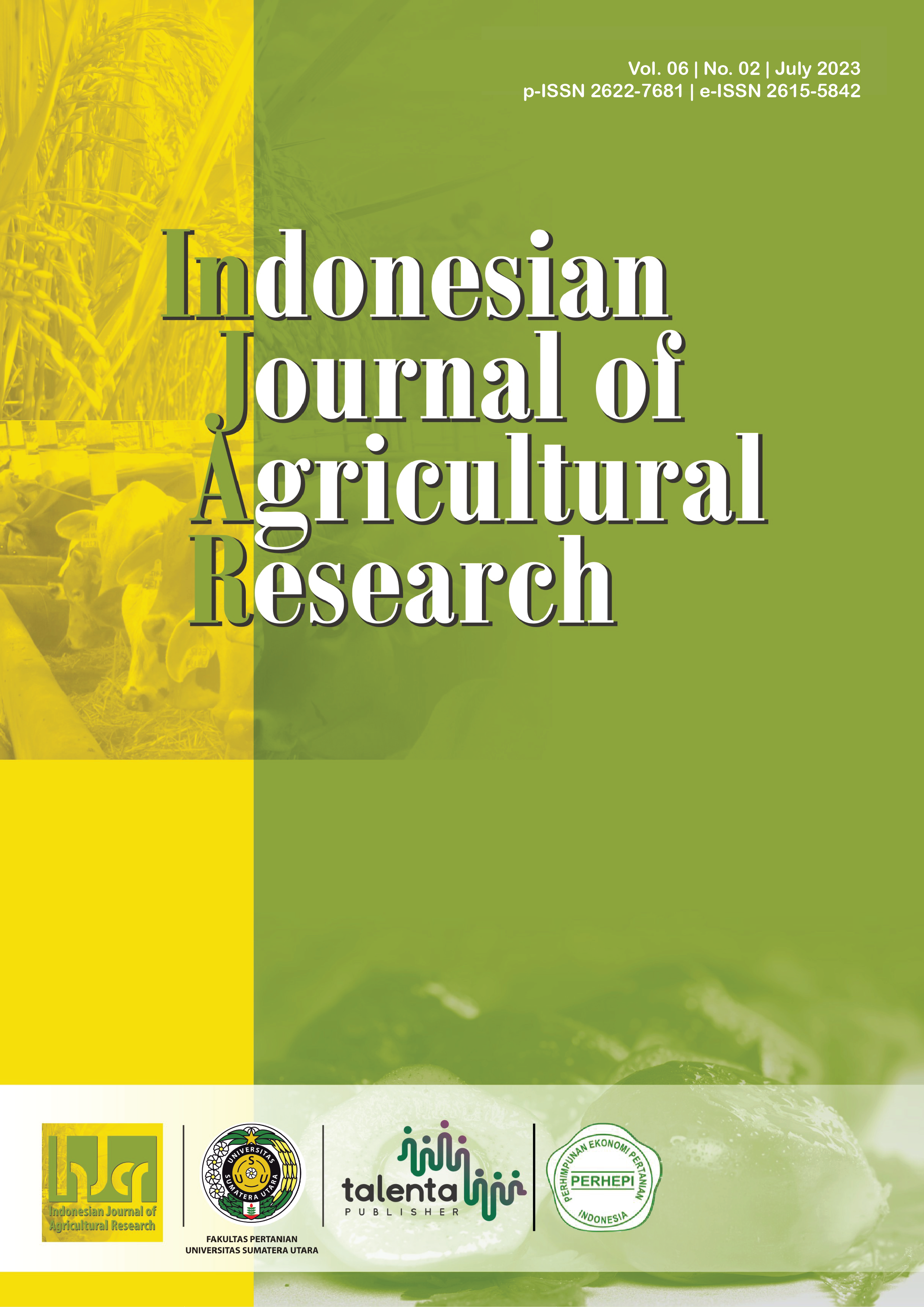Antimycotic Inhibition of Phytophthora colocasiae (Taro Leaf Blight) Using Diverse Disease Management Paradigms
DOI:
https://doi.org/10.32734/injar.v6i2.11913Keywords:
botanical, cocoyams, lesions, Peronosporales, tuber cropAbstract
Cocoyam/taro production has been plagued with many constraints, especially taro leaf blight. This study aimed at providing useful control options for the management of taro leaf blight. Two in vitro sub-trials (using botanicals alone or chemicals+botanicals) were conducted. A completely randomized design with each treatment replicated thrice was used and analyzed at a 95% confidence level. P. colocasiae was effectively inhibited by Balsam, Thyme, Lantana, Eucalyptus, and Alligator-pepper up to 144 Hours After Inoculation (HAI) with a 144-HAI-moving average of 69.5%. At 48, 96, and 144 HAI, Eucalyptus 100% concentration, Thyme (50 and 100%), Lantana 100%, and Alligator-pepper (50 and 100%) were excellent control resources. Percentage inhibition of the pathogen by plant extracts ranged from 13.8-100%. Combinations of Mancozeb and MetCop (i.e. Metalaxyl+Copper(I)oxide) with botanicals (Balsam, Lantana, and Thyme) controlled P. colocasiae. Inhibition of radial growth of P. colocasiae ranged from 0-100% with a 168-HAI-moving average of 55.5%. Combining Thyme with Mancozeb or MetCop significantly inhibited P. colocasiae more compared to other treatments. Mancozeb+Balsam 50% and MetCop+Balsam 100%, followed by Mancozeb+Lantana 100%, MetCop+Lantana 100%, and Mancozeb+Balsam 100% were the best treatments. Mancozeb was better than MetCop. Chemical rates can be reduced by using botanicals since chemicals affect health.
Downloads
References
K. M. Tabi, G. Ntsomboh-Ntsefong, L. B. Tonfack and E. Youmbi. “Field management of taro (Colocasia esculenta (L.) Schott) leaf blight via a fungicidal spray of foliage,†J. Cameroon Academy of Science, vol. 16, no. 3, 2021. [Online] Available https//dx.doi.org/10.4314/jcas.v16i2.
N. V. Chiejina and F. N. Ugwuja, “Incidence of Phytophthora leaf-blight disease of cocoyam in Nsukka area of south-eastern Nigeria,†Journal of Botanical Research, vol. 4, no. 1, pp. 21-24, 2013. ISSN: 0976-9889. E-ISSN: 0976-9897.
R. S. Misra, K. Sharma, and A. K. Mishra, “Phytophthora leaf blight of taro (Colocasia esculenta) – A Review,†Asian and Australasian Journal of Plant Science and Biotechnology, 2008. Global Science Books.
A. F. Lum, and M. C. Takor, “Taro leaf blight: disease assessment, farmers’ knowledge and management potential of goatweed extract in South West Cameroon,†Journal of Agriculture and Crops, vol. 7, no. 4, pp. 159-166, 2021. [Online] Available https://doi.org/10.32861/jac.74.159.166.
L. A. Fontem, D. Chikoye, C. Fokunang, and E. M. Ndifon, “Weeds as potential biopesticides in taro leaf blight disease management,†Res. Applica. Summary, RUFORUM, pp. 313-316, 2014.
G. A. Mbong, C. N. Fokunang, L. A. Fontem, M. B. Bambot, and E. A. Tembe, “An overview of Phytophthora colocasiae of cocoyams: A potential economic disease of food security in Cameroon,†Discourse Journal of Agriculture and Food Science, vol. 1, no. 9, pp. 140-145, 2013.
R. Reshu and M. M. Khan, “Role of different microbial-origin bioactive antifungal compounds against Alternaria spp. causing leaf blight of mustard,†Plant Pathology Journal, vol. 11, pp. 1-9, 2012.
H. L. Barnett and B. B. Hunter, “Illustrated genera of imperfect fungi,†Burgess Pub. Co. Mineapolis, pp. 246-249, 1972.
E. M. Ndifon, “Management of Globisporangium ultimum infecting groundnut and Bambara groundnut pods using diverse methods,†New countryside, vol. 1, no. 1, pp. 13-20, 2022a. [Online] Available https://doi.org/10.55121/nc.v1i1.27
C. C. Iwuagwu, A. C. Nwagbaga, F. C. Onejeme, U. F. Nduka, and D. E. Iheaturu, “In-vitro effect of some plant extracts and synthetic fungicide in the control of cocoyam leaf necrotic fungi in Aguata L.G.A., Anambra State,†International Journal of Biotechnology and Food Science, vol. 6, no. 5, pp. 86-94, 2018.
S. H. Wavare, R. M. Gade and A. V. Shitole, “Effect of plant extracts, bioagents and fungicides against Sclerotium rolfsii causing collar rot in chickpea,†Indian Journal of Pharmaceutical Science, vol. 79, no. 4, pp. 513-520, 2017. [Online] Available DOI:10.4172/pharmaceutical-sciences.1000257
F. Hussain, M. Abid, S. Shahid, S. Farzana and M. Akbar, “Anti-fungal activity of some medicinal plants on different pathogenic fungi,†Pakistan Journal of Botany, vol. 47, no. 5, pp. 2009-2013, 2015.
E. M. Ndifon and A. F. Lum. “Assessment of white yam tuber rot disease and in vitro management of Aspergillus niger in Ebonyi State, Nigeria,†International Journal of Bioscience, vol. 19, no. 4, pp. 32-40, 2021. ISSN: 2220-6655 (Print), 2222-5234 (Online). http://www.innspub.net. DOI: http://dx.doi.org/10.12692/ijb/19.4.32-40
P. G. Chavan, K. T. Apet and B. R. Sawade, “Efficacy of botanicals against Pythium aphanidermatum causing rhizome rot of turmeric,†Journal of Science, Agriculture and Engineering, vol. 8, no. 27, 2018. ISSN 2277-7601. [Online] Available www.ycjournal.net
S. Sanasam, D. R. K. Sanatombi, D. N. Beenakumari, and S. O. Shashikumar, “Antagonistic activities of plant extracts against the phytopathogen sclerotium rolfsii, during pre-harvest horticultural practice - a component of integrated disease management,†International Journal, 2018.
E. M. Ndifon, M. Chiv, P. Iyang, E. Ankrumah, C. P. O. Emeka and I. O. Chinaka, “Effect of plant extracts on Fusarium oxysporum f.sp melongenae wilt and growth of African garden egg (Solanium aethiopicum L.) in Makurdi,†Notulae Scientia Biologicae, vol. 14, no. 2, 2022b. [Online] Available https://Doi:10.15855/nsb14210912.
S. Sneha, S. Maurya and A. K. Choudhary, “Antifungal efficacy of garlic and ginger against Sclerotium rolfsii,†International Journal of Agriculture and Science Research, vol. 6, no. 6, pp. 419-424, 2016. ISSN(P): 2250-0057; ISSN(E): 2321-0087.
E. B. Manju, C. N. Fokunang, G. A. Mbong, T. S. Tima, C. Suh, et al, “Impact of fungicide application on taro leaf blight disease in three regions of Cameroon,†Journal of Expermintal Agriculture International, 2017. [Online] Available https://dx.doi.org/10.9734/jeai/2017/33915.
Downloads
Published
How to Cite
Issue
Section
License
Copyright (c) 2023 Indonesian Journal of Agricultural Research

This work is licensed under a Creative Commons Attribution-NonCommercial-ShareAlike 4.0 International License.



















